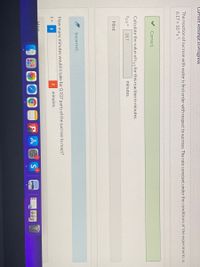
Chemistry
10th Edition
ISBN: 9781305957404
Author: Steven S. Zumdahl, Susan A. Zumdahl, Donald J. DeCoste
Publisher: Cengage Learning
expand_more
expand_more
format_list_bulleted
Question

Transcribed Image Text:Current Attempt in Progress
The reaction of sucrose with water is first order with respect to sucrose. The rate constant under the conditions of the experiments is
6.17 x 104 s 1.
Correct.
Calculate the value of t1/2 for this reaction in minutes.
t1/2 =
18.7
minutes.
Hint
Incorrect.
How many minutes would it take for 0.937 parts of the sucrose to react?
t =
i
minutes.
Hint
Expert Solution
This question has been solved!
Explore an expertly crafted, step-by-step solution for a thorough understanding of key concepts.
This is a popular solution
Trending nowThis is a popular solution!
Step by stepSolved in 2 steps

Knowledge Booster
Learn more about
Need a deep-dive on the concept behind this application? Look no further. Learn more about this topic, chemistry and related others by exploring similar questions and additional content below.Similar questions
- Calculate grams of sucrose that must be added to 206.8 grams of water to prepare a 18.32 % by mass solution. a. 46.4 b. 139 c. 92.8 d. 0.0969 e. 23.2arrow_forward4. All the CaSO4 present in 0.511g of an impure sample of plaster is converted to 0.821g BaSO4. What is the % of CaSO4 in that sample?arrow_forwardA scientist needs to make a 250 mL of a solution of ethanol in water that has a molaritv of 0.12 Unfortunately, the only scales are available. [Water: M = 18.02 g/mol, d=0.997 g/mL] [Ethanol: M = 46.07 g/mol, d = 0.789 g/mL]) a. Calculate the mass of each substance needed to make this solution. b. Calculated the volume percent of each substance?arrow_forward
- 1. Knowing that one day is 24 hours and one hour is 60 minutes, how many minutes are in 2.0 days?2. How many liters is 57.4 mL?3. Calculate the grams of ethane present in a sample containing 0.3850 moles if the molar mass of ethane is 30.067 g/mol.4. Calculate the moles of ammonia present in a 7.040 g sample of ammonia, which has a molar mass of 17.030 g/mol.5.arrow_forward8. For each compound, pick the better solvent for dissolving it, water or hexane (C6H14). a. I2 b. NaBr c. Ethanol, CH:CH2OH d. benzene, C6H6arrow_forwardWhich of the following can be used to find moles in a stoichiometry calculation? а. The molarity of a solution and it's volume. b. The mass of a solid and it's molar mass. С. The pressure, volume, and temperature of an ideal gas. d. All of the abovearrow_forward
- CHAPTER 8 - SOLUTIONS Submit Qu O Previous Page 9 of 35 E Next O References Use the References to access important values if needed for this question. A certain salt is known to have a solubility in water of 28.9g/100g water at 100°C and 10.9g/100g water at 20°C. The salt is dissolved in 230 g of water at 100°C until no more solid will dissolve How much salt will crystallize out when the solution is cooled to 20°C?arrow_forwardPotassium nitrate (KNO3) occurs naturally as the mineral saltpeter in Italy, and many other places. It is easy to mine, and highly endothermic when it is dissolved in water. Because of this, members of the Roman nobility often dissolved saltpeter in large urn when they had parties. Which of the following is the most likely application of this technology? Oa. a. The Romans used saltpeter to chill their wine. Ob. The Romans used saltpeter to light their dining halls. Oc. The Romans used saltpeter to cook their fish course. Od. The Romans used saltpeter as a warm soak for their guests' feet.arrow_forward128 CHAPTER 5 3. A chart of vapor pressure information at different temperatures for various liquids is given below. Vapor Pressure (torr) Temperature Water Ethyl Alcohol Carbon Tetrachloride O'H 4. 24 (C) HOʻHƆ 12 34 0. 25 116 09 224 95 316 75 294 675 731 760 1723 1486 The questions below refer to the following experiment: three flasks, each containing one of the three liquids listed in the table are hooked to a vacuum pump. The pressure in each flask is reduced to 50 torr and the temperature of each flask is maintained at 25°C. blano (b) (a) Under these conditions, which liquid(s) would you observe boiling? Explain. (b) Explain why, if both liquids are maintained at 25°C, the vapor pressure of CCI, is higher than the vapor pressure of C,H,OH. Refer to both molecules in your discussion. CH H'C CH enstud-S-otoahib-CS-uot OBO 2ADI ud,8gada al sanm alom omss odi ovard asonatadue dhol () palom alimis bas Dwal s ad mot ab at a tmioq gaiilam Dwal inlqx ToonanoROT atidio ym li mol diW )…arrow_forward
arrow_back_ios
arrow_forward_ios
Recommended textbooks for you
 ChemistryChemistryISBN:9781305957404Author:Steven S. Zumdahl, Susan A. Zumdahl, Donald J. DeCostePublisher:Cengage Learning
ChemistryChemistryISBN:9781305957404Author:Steven S. Zumdahl, Susan A. Zumdahl, Donald J. DeCostePublisher:Cengage Learning ChemistryChemistryISBN:9781259911156Author:Raymond Chang Dr., Jason Overby ProfessorPublisher:McGraw-Hill Education
ChemistryChemistryISBN:9781259911156Author:Raymond Chang Dr., Jason Overby ProfessorPublisher:McGraw-Hill Education Principles of Instrumental AnalysisChemistryISBN:9781305577213Author:Douglas A. Skoog, F. James Holler, Stanley R. CrouchPublisher:Cengage Learning
Principles of Instrumental AnalysisChemistryISBN:9781305577213Author:Douglas A. Skoog, F. James Holler, Stanley R. CrouchPublisher:Cengage Learning Organic ChemistryChemistryISBN:9780078021558Author:Janice Gorzynski Smith Dr.Publisher:McGraw-Hill Education
Organic ChemistryChemistryISBN:9780078021558Author:Janice Gorzynski Smith Dr.Publisher:McGraw-Hill Education Chemistry: Principles and ReactionsChemistryISBN:9781305079373Author:William L. Masterton, Cecile N. HurleyPublisher:Cengage Learning
Chemistry: Principles and ReactionsChemistryISBN:9781305079373Author:William L. Masterton, Cecile N. HurleyPublisher:Cengage Learning Elementary Principles of Chemical Processes, Bind...ChemistryISBN:9781118431221Author:Richard M. Felder, Ronald W. Rousseau, Lisa G. BullardPublisher:WILEY
Elementary Principles of Chemical Processes, Bind...ChemistryISBN:9781118431221Author:Richard M. Felder, Ronald W. Rousseau, Lisa G. BullardPublisher:WILEY

Chemistry
Chemistry
ISBN:9781305957404
Author:Steven S. Zumdahl, Susan A. Zumdahl, Donald J. DeCoste
Publisher:Cengage Learning

Chemistry
Chemistry
ISBN:9781259911156
Author:Raymond Chang Dr., Jason Overby Professor
Publisher:McGraw-Hill Education

Principles of Instrumental Analysis
Chemistry
ISBN:9781305577213
Author:Douglas A. Skoog, F. James Holler, Stanley R. Crouch
Publisher:Cengage Learning

Organic Chemistry
Chemistry
ISBN:9780078021558
Author:Janice Gorzynski Smith Dr.
Publisher:McGraw-Hill Education

Chemistry: Principles and Reactions
Chemistry
ISBN:9781305079373
Author:William L. Masterton, Cecile N. Hurley
Publisher:Cengage Learning

Elementary Principles of Chemical Processes, Bind...
Chemistry
ISBN:9781118431221
Author:Richard M. Felder, Ronald W. Rousseau, Lisa G. Bullard
Publisher:WILEY